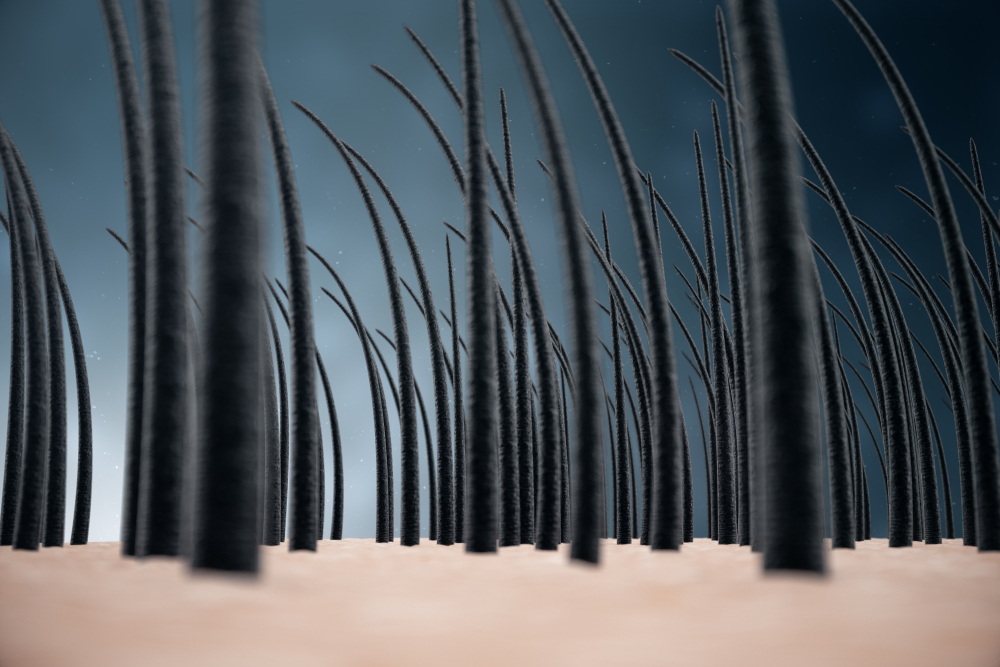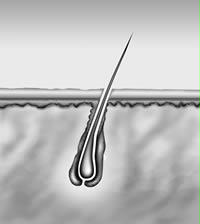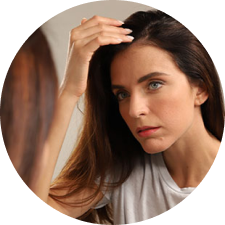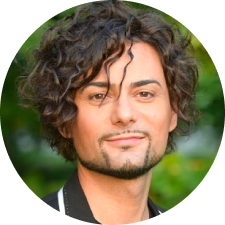- Home
- Hair follicles and bulbs
hair
Hair follicles and bulbs
Scientific collaboration between Professor Marco Toscani and Dr. Pasquale Fino, Chair of Plastic, Reconstructive and Aesthetic Surgery, Umberto I Health Center – “Sapienza” University of Rome.

A hair follicle is a formation of epidermal origin, anchored in the dermis and consisting of a hair and its sheath.
The formation of hair follicles occurs early. They begin to appear as early as the second month of gestation. These follicles will continue to form for the entire duration of the pregnancy. At birth, the baby will indeed have the entire supply of follicles with which it was genetically equipped and from this moment on, no others will form.
The hair follicle anchors into the skin following a certain inclination, and for this reason our hair is usually not straight, but slightly inclined.


The portion that sticks out of the skin, visible and external to the follicle, is called the hair shaft (its average thickness in adults is 65-78 microns). The inner part of the follicle itself, located between the ostium of the follicle and the insertion point of the arrector pili muscles, is called the root. Usually it is not visible, is ‘immersed’ in the skin and surrounded by different sheaths.
Behind the sebaceous gland, which spills its contents onto the hair follicle, is a small muscle called the arrector pili muscle. This band of muscle fiber is attached to the follicle, on one end, and to the more superficial or outer dermis, on the other, where it continues, opening up in the form of a fan. The arrector pili muscle is activated in response to cold or following the sensation of fear. By contracting, it makes the hair shaft raise up, making the skin around the follicle wrinkle and rise visibly, resulting in “goose bumps”.
An even deeper portion, lodged in the base of the hair follicle, where the dermal papilla – full of blood vessels and nerve endings – is inserted, is called the bulb. Its lower part (basically the ‘floor’) contains two-three rows of cells undergoing rapid reproduction: these constitute the matrix (continuing from the external epithelial root sheath of the follicle). Inside the bulb is the hair, enveloped by the internal epithelial root sheath, which is then surrounded by the external epithelial root sheath. All of the above is enveloped by a sort of connective tissue membrane, i.e. composed of fibers.
It should be noted that the bulb, in the lower part, is structured to house the dermal papilla, a highly vascularized structured which supplies the essential elements for its activity. The bulb is responsible for ensuring germination and proliferation of the hair, thus it it has the task of nourishing it.
A healthy bulb is round and its diameter is decidedly wider than that of the hair shaft.
Each hair is surrounded by many nerve endings.
The hair shaft has a diameter of around 70-100 μm and is composed of three continuous layers called, from the inside out, the medulla, cortex and cuticle.
Absent in the thinnest hairs, the medulla is composed of large cells with wide interstitial spaces full of air (which may influence the color of the hair).
The cortex is the main part, and is composed of several layers of dead, flattened cells (i.e. without a nucleus or organelles), very similar to those present in the corneum layer of the skin. These cells have pigment thanks to the presence of melanocytes located in the bulb.
The outermost portion, called the cuticle, consists of a single layer of very thin, transparent cells (lacking pigment). These cells are layered similarly to shingles on a roof, and are responsible for protecting the underlying cortex. Under a microscope, they look like small scales, with free edges pointing outwards. In the root of the hair, the most internal layer of the follicle also features cells layered similarly to shingles on a roof, but in the opposite direction, i.e. with the free edge aimed inwards. Thanks to these anatomical features, the cells of the cuticle are wedged in between those of the follicle wall, improving anchorage of the hair in this region.
The cells from the lower part of the bulb, which surround the dermal papilla, are called hair matrix epithelial cells. These are a group of undifferentiated cells that are capable of actively dividing for mitosis. The new cells that originate from this division detach, forming the three layers of the hair or of the internal epithelial root sheath, in turn also composed of three layers.
The bulb contains various groups of cells specialized in germination and proliferation of the hair.
The internal epithelial root sheath is responsible for shaping the hair shaft, i.e. for forming a sort of rigid casing in which the hair grows and lengthens. This rigidity is due to the presence of keratin.
The external epithelial root sheath is composed of the epidermis, which sinks into the dermis and is composed of several layers of support cells.
On a further external level, the connective membrane is composed of collagen fibers (which ensure a certain robustness of the follicle). It has a support function and contains both vessels and nerves.
From a structural point of view we can observethe following in the hair follicle, proceeding from the outer layer inwards: the connective tissue sheath (full of nerve endings and composed of concentric and longitudinal layers of collagen fibers with numerous fibroblasts); the vitreous membrane (a direct continuation of the cutaneous basement membrane); the external epithelial root sheath (a direct continuation of the deeper layers of the epidermis that follow the vitreous membrane down); the internal epithelial root sheath, consisting of three layers of cells that originate, like those of the hair, from cells of the matrix.
Hair and Scalp
READ ALL ARTICLESHair Loss
READ ALL ARTICLESHair Problems
READ ALL ARTICLESScalp Problems
READ ALL ARTICLESAlopecia
READ ALL ARTICLESPreventions and Solutions
READ ALL ARTICLESHair loss solutions for you. CRLAB, specialists in the well-being of your hair and scalp.
FIND YOUR NEAREST CENTER
Let our experts find the best solution for you.
FIND YOUR NEAREST CRLAB CENTERBOOK A CONSULTATION
Book a consultation with our experts. Find out more about CRLAB solutions.
MAKE AN APPOINTMENTTrichology scalp and hair care
To put the health back into your hair, you first need to nourish your scalp. Our trichology treatments care for your scalp and hair, using cutting-edge technologies with a full range of laboratory-tested products. All made with high quality raw materials.
Find out moreHair prosthetic system
The ultimate answer to your hair loss. Rediscover yourself, with naturally thick hair. A patented solution that integrates real hair into areas where you’re experiencing thinning or hair loss. A fully customized hair enhancement that will look totally natural on you. Plus, it’s so functional, it gives you the freedom to live your life the way you want to.
Find out moreHair transplant surgery
Hair transplantation is recommended for those who wish to improve hair density and coverage. The degree of thinning may vary and must be assessed in relation to the donor area.
Find out more
 Italiano
Italiano  Português
Português  Français
Français  Español
Español 




